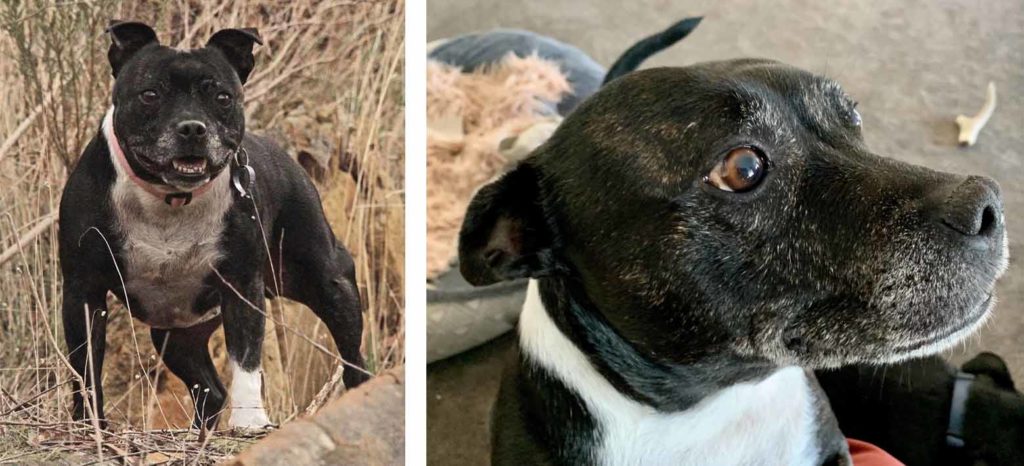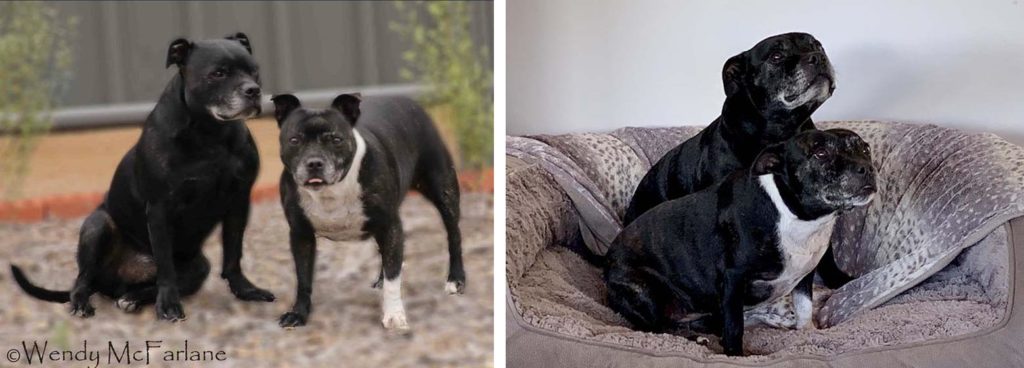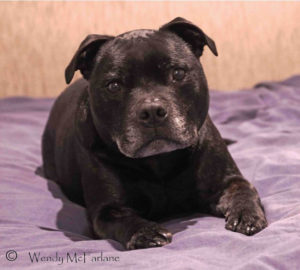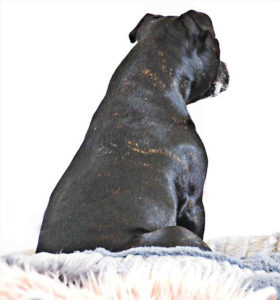
Stafford Rescue Victoria
Jan Hutton’s rescue story is an interesting one. She started off helping people re-home Staffordshire Bull Terriers on a case by case basis. That was 13 years ago.
There’s no doubting the popularity of the breed. “We got our social media presence out there in 2011 and everything started to come together”, Jan said. “We established our charity status in 2013. It’s certainly the way to go for rescue groups. We’d have over 25,000 followers on our Facebook account. If you think that’s a lot, Jenny Hall, The Blueboys owner, has 1.2 million on Facebook and Instagram combined! The Blueboys’ calendar is sold in the UK, the USA and Australia. A percentage of the proceeds from the Australian sales is donated to us, and UK and US rescue groups, according to the respective sales, receive a percentage as well. Her Christmas appeal raised over $100,000 in 48 hours which was distributed amongst six or eight rescue groups. Last year, from sales of her Darren & Phillip clothing line, she donated a percentage to rescuers. The Blueboys have been wonderful sponsors of our cause”.
One of their biggest problems Jan said was keeping their foster carers. While it spoke volumes of the endearing nature of the breed, it also put a strain on the rescue network. “So many of the dogs start off as fosters and finish up being adopted. Very very rarely do we get a foster carer who gives the dog back. Over the 13 years I’ve been involved it would only be 2-3 fosters that have come back. They’re so affectionate and loyal. In the old days they’d leave the dog to mind the children while they went down the mine or off to the mill. Hence the name the Nanny Dog”. In what could be the breed’s motto, Jan said. “They’re not dogs; they’re Staffords”.

Jan’s staffie Bindi
The full name of the breed is Staffordshire Bull Terrier, but for convenience is often referred to as the Stafford or Staffie. There are two theories as to its origins, both in our less genteel past, but both from breeds developed for the ‘entertainment’ of pitting dogs against other dogs or animals. And let’s be honest here, you only have to read Anne Sewell’s Black Beauty or some of Dickens novels to gauge how our attitudes and behaviour have changed since we lived in those less enlightened times amongst those dark satanic mills. And so has the temperament of the dog we now affectionately know as the Staffie. Our regular reference point, Wikipedia, has this to say about it.
Over the course of a few centuries and generations of responsible breeding and further breed refinement, the Staffie has evolved into a popular family pet and companion dog. They are considered loyal, courageous and affectionate, and are among the dog breeds recommended by the Kennel Club as suitable for families with children. They have a reputation for pugnaciousness, and when challenged by another dog it is characteristic of them to not back away. It is often recommended that Staffies receive early socialisation, preferably beginning when they are still puppies.
But the Wikipedia item that most caught our eye was this one. It reads like something you’d expect on SBS’s popular ancestry exploration show Who Do You Think You Are.
In the mid–19th century, James Hinks wanted to develop a socially acceptable “gentleman’s companion” with refinement, cleaner lines, and courage without the aggressive tendencies (of the now extinct Bull & Terrier used for animal baiting). Two different types of Bull & Terriers resulted, including Hink’s cross of the Bull & Terrier with the English White Terrier to achieve a more refined appearance with better legs and a nicer head. A later outcross included the Dalmatian and Collie which led to the development of an athletic white dog known as Hink’s “white cavalier”, the forerunner to the modern Bull Terrier. Devotees preferred the original Bull & Terrier type over Hink’s Bull Terrier, and remained loyal to their preferred type, which became the modern Staffordshire Bull Terrier of the same ancestry as the Bull Terrier.
So there you go.
Jan made the point that there was some confusion with the name. “People call them English Stafford bull terrier. There‘s no such thing as an English Stafford bull terrier. They’re a Staffordshire Bull Terrier from England. The American Staffordshire Terrier is a totally different breed of dog”.

Bindi and Irwin checking things out
Being a breed-specific rescue gave Jan and her colleagues at Stafford Rescue Victoria (SRV) certain responsibilities while at the same time empowering them to carry out those responsibilities fairly and judiciously. “None of our dogs are inherently bad, but they are a bull breed so we are careful where they go. We probably do a bit more due diligence that the average rescue group. We have to be sure that where our Staffords are placed – that the people have the leadership skills to command the dog – so we get Trish Harrison from Four Paws K9 Training to do a behavioural assessment. It works out well for everyone that way and the new owners appreciate the professionalism”.
Space and human resources are a factor that limits the number they can handle. One year they rescued and re-homed just under 200 Staffords. They’re in the throes of building five new kennels at a nearby farm to help extend their ability to re-home more dogs. There’ll also be paddock space to rescue farm animals as well.
Their priority with the new facility will be to save Staffords that find themselves on ‘death row’ at pounds and the people who have had to surrender dogs but lack the network to re-home them. A common reason Jan comes across is, “Oh, we’re having children now and can’t have the dog around”, which, it could be said, is a long way from going down the mine or off to the factory floor and leaving the Nanny Dog behind to protect the children.
Other reasons Jan often comes across is the issue of renting. Some rental accommodation won’t allow pets which leads to a surrender. Another is the young lad who loved his dog when he was young but has left home for work or tertiary education. He has his hands full – in many cases, dogs and pets are victims of the no-pet rental ban – and the parents rehome the animal through Stafford Rescue Victoria.
“A dog’s diet has a lot to do with their behaviour and health: anxiety, coat, skin, everything”
Jan said the popularity of the breed makes them a lucrative proposition for backyard breeders and puppy farms. “This in turn leads to over-breeding which creates a problem for Stafford rescues here in Victoria and other states. Across Australia, rescuers find themselves dealing with the aftermath of these puppy factories”.
The breeding for colour is another issue. As Jan explained, “There are more blue Staffords bred than all the other colours put together. They get a premium price for blue pups; the tiger brindle, a beautiful dog, is now rare”.
As a matter of interest, here’s what our friends at Wikipedia have to say about SBT colouration.
The Stafford’s coat is short, stiff and close. Base colours can be red, fawn, white, black or blue, or any one of the aforementioned with white, any shade of brindle or any shade of brindle with white.
But, as Jan said, “The prices obtained are leading to a boom in breeding, licenced or otherwise. Kennel clubs throughout Australia have stated that there’s more people applying to breed Staffordshire Bull Terriers than any of the other breeds. It would be nice if there was a limit on popular breeds of dogs then we won’t be saturated with these excess animals. Say you had to wait until one of those breeders retires and offers their licence for sale. A limit like abalone diving licenses to help manage the numbers. We’ve got to stop people churning out puppies just to make money. And have more restrictions on them. Monitor how this side of the industry is run”.
Jan would like to see other stakeholders in the breeders’ chain help out with the downstream problems with which her colleagues in the rescue community have to deal. “Kennel clubs collect the registration fees but they don’t give any of that back to the rescue groups. There’s a lot of breed-specific rescue groups out there that get nothing for providing a safety net for the over-breeding. And the breeders don’t give you anything”.
Jan felt that one way to solve a serious problem was for a more responsible attitude by backyard breeders. She felt that with the opportunity should come accountability. “I see a way around this by changing their name to home-breeder. They could pay the Council a realistic amount of money to sit a training course on breeding and animal health. Be educated on what to do and what not to do. There are so many issues, particularly as far as animal health is concerned. When they pass the test and receive accreditation – and only then – can they apply for registration for home-breeding. The whole thing can be set up professionally, maybe the TAFE colleges could help with the course structure and certification. That would be a win all round, wouldn’t you think? A well-trained breeder and an additional training course for the TAFE system”. With her tongue placed firmly in her cheek, she added, “They could even devise a course for dog owners while they’re about it. It lifts the bar, sure, but what’s wrong with that? Capable care is the least the animals should expect to receive.

Another of Jan’s staffies – Irwin
“Hundreds of thousands of dogs are being put to sleep each year; and that’s just because there are too many dogs being bred. Why are rescue groups needed? There are also too many cats being bred, too many ponies & horses. It’s just greed. Shar pei rescues – German shepherd rescues – every breed of dog you could imagine; why are we having to clean up all the mess? We don’t get on-going government funding. Thankfully we did get $50,000 grant from Animal Welfare Victoria to build the new shelter. We raised the first $50,000 and the government matched our fund-raising effort. Then Jenny Hall donated $30,000 from The Blueboys activities”.
Financing is one thing, and there’s more to rescue than just handling and caring for the animals. Budget responsibility, administration and rescue co-ordination are all part of the mix. And let’s not forget fund raising. Jan is the President of SRV, Shannon Hellingham is Vice President and cares for the dogs at the kennels. Olga Avramov is the Treasurer and Simon Barnett the Secretary. Katy King is in charge of setting up events such as the Dog Lovers’ Show and the numerous Pets-in-the-parks, and much, much more. Events are crucial in keeping the activities of SRV in the public eye. Then there’s the volunteer co-ordinator: Angela Torrence. This entails organising the rosters for the SRV kennels. The rest falls to Jan. She’s on the phone or the computer before breakfast and often still there at nine o’clock at night dealing with the myriad of issues, large and small, that crop up endlessly.
“I help with the legal side of things as well. If the issues are too much for us we pass the matter on to Michael Faltermaier Lawyers. The principal of the firm, Michael Faltermaier, specialises in dog law, and we’re very fortunate to be able to call on him”.
“They could pay the Council a realistic amount of money to sit a training course on breeding and animal health. Be educated on what to do and what not to do”
Jan had no doubts that what a dog eats influences the wellbeing of the animal. “A dog’s diet has a lot to do with their behaviour and health: anxiety, coat, skin, everything. With bull breeds, grass allergy is quite common. They roll on the wet grass and scratch under their arms, rub themselves on the carpet; it’s like a contagion.
“I had one owner, she sent me photos of her six-month-old Stafford and it was red raw. I asked her to change her diet and it went away. I get many of those calls”.
Dog rescuing takes a mighty effort and plays a crucial role in the overall wellbeing of our fur-friends; one that too often goes unrecognised. From the above, there’s no doubting the effort, the cost and the selfless dedication that goes into rescue groups. And being on the frontline, there’s no doubting that Stafford Rescue Victoria has experience in and a clear understanding of the concerns with which the sector has to deal.

Irwin giving a cold shoulder
Jan Hutton can be contacted through their website at http://staffordrescuevictoria.org.au/
We would like to recognise and thank Wendy McFarlane for granting approval to use her gorgeous photos, more of her work can be found here.
